PRESTO PLANS
Sent straight to your inbox
CLICK HERE TO ACCESS
Sign up to receive 10 ready-to-use ELA resources your students will love!
10 FREE ELA RESOURCES
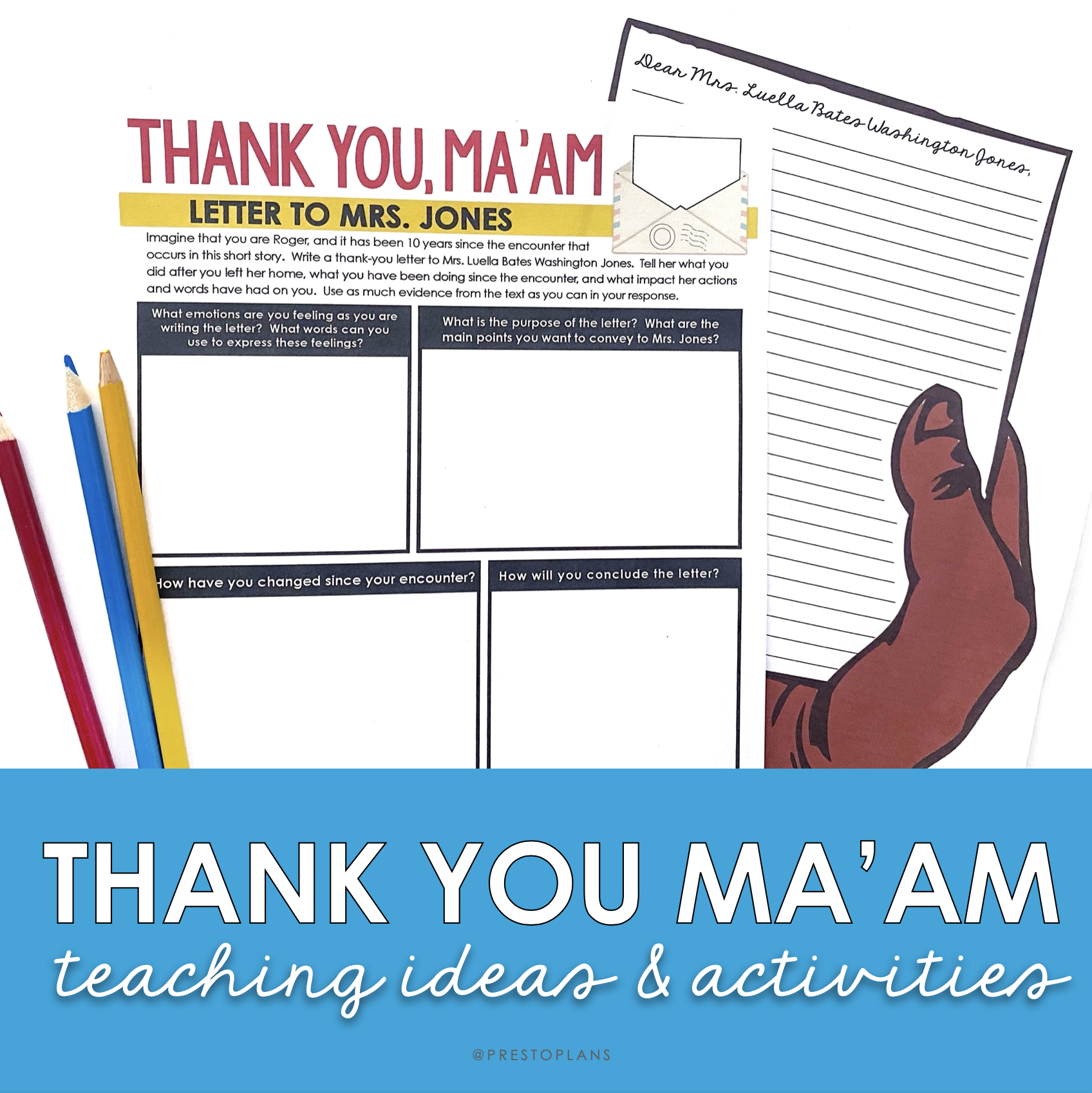
Teaching Thank You Ma’am by Langston Hughes
If you are teaching “Thank You, Ma’am” by Langston Hughes, you may be looking for strategies and tips for analyzing this powerful short story. Not to fear as I’m sharing my best tips for helping you navigate all elements of the text with your students.
“Thank You, Ma’am” centers around a boy named Roger, who tries to steal the purse of a woman while she is walking home alone at night. When the boy is unable to get away with his crime, he expects punishment. Instead, Mrs. Luella Bates Washington Jones shows him a level of kindness he will never forget.
So, where to begin when teaching this short story? Below are some tips to bring this story to life for your middle or high school students.
Build Background Information
Before introducing any short story to your students, I would suggest providing any context that students may need to fully understand the background of the story. For “Thank You, Ma’am,” I like to focus on these two elements of context in particular:
- Author
- Historical
Introduce students to Langston Hughes with a biographical overview and highlight key moments in his life and career. This gives students a sense of who is telling this story and shows how the author’s life is reflected in the plot line. For example, Hughes was an American writer (poet, playwright, novelist, and columnist) who is best known as the leader of the Harlem Renaissance.
You’ll also want to spend some time focussing on the historical context of the story. This is where I like to go into more detail about the Harlem Renaissance. You can explain how during this period, an influx of African-American literature, art, and music celebrated a new cultural identity, as well as how the movement also emphasized the importance of political, social, artistic, and economic freedom for African Americans. “Thank You, Ma’am,” like many of Hughes’ short stories, is set in Harlem, New York.
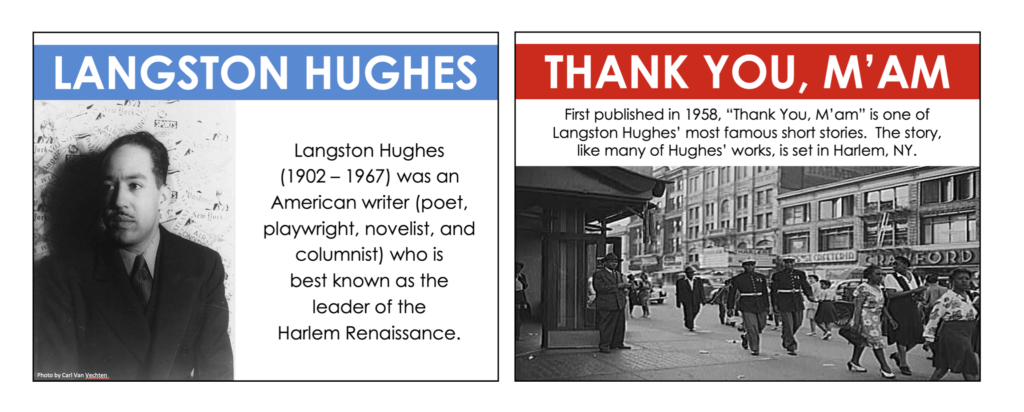
Pre-Reading
Before diving into the story itself, I suggest having students respond to discussion questions so that they can further invest themselves in the story by establishing opinions related to the subject matter. I like to use questions related to the power of kindness and giving second chances, which are important themes in the story. I might ask questions like…
- Should people be given a second chance after doing something wrong (lying, stealing, etc.)?
- A famous African proverb says, “It takes a village to raise a child.” Do you think this is true?
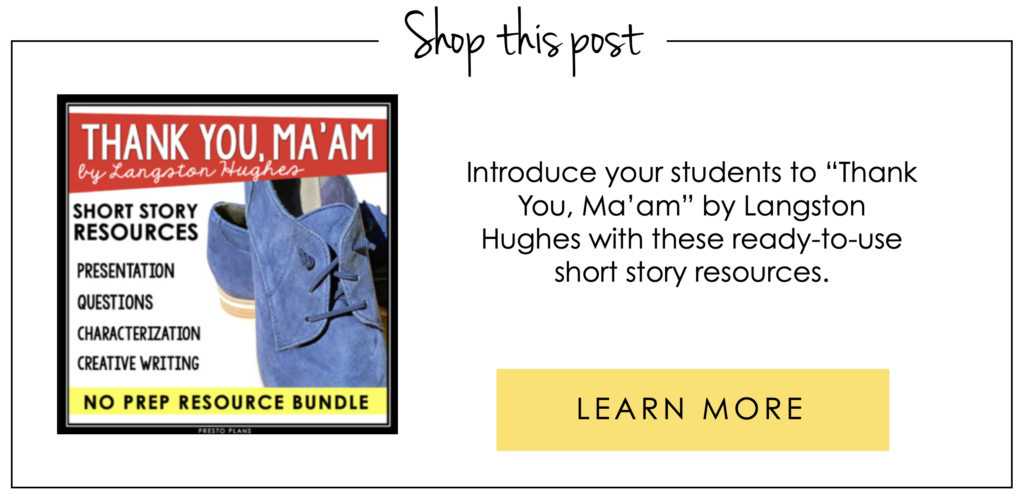
During and Post Reading
Now it’s time for students to read the text. I like to stop the class from reading from time to time to ensure comprehension. Then, once everyone is done the story, I engage students in post-reading discussion. These discussion questions allow students to reflect on what they have read and to share their thoughts and ideas with their peers, first in small groups and then as a whole class.
There are a few types of questions that I find work well here. I usually give students an open-ended question that prompts them to reflect on the central themes in the story, as well as others that prompt them to make text-to-self connections. Here are a couple of examples:
- What are some reasons that people commit crimes?
- How do you think you would have reacted if you were in Mrs. Jones’ position?
- Would you have run if you were Roger? Why or why not?
Analysis Questions
After finishing our post-reading discussion, I then give students a handout with some reading questions that force students to dive a little bit deeper into the text on their own. These questions prompt students to analyze the text in a more substantial way; the questions are more specific, and I ask them to give text evidence in their responses. Here are a couple of examples of the types of analysis questions I give here:
- Why doesn’t Mrs. Jones call the police? What do you think are her intentions with the way she deals with the situation with Roger?
- Explain the meaning of the following quote from the story: “Shoes got by devilish ways will burn your feet?” What lesson does it teach about life?
Once students have finished, we go over the answers together as a class, and I model a strong response for students on the board.
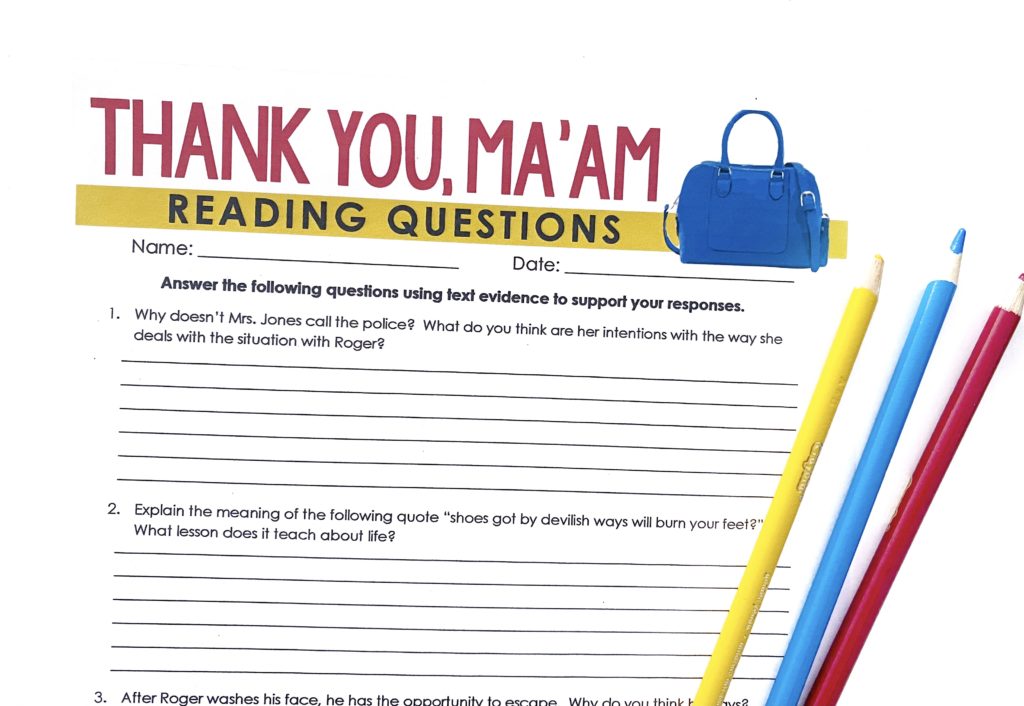
Character Analysis
Hughes’ use of characterization can be subtle at times. To have a strong understanding of Roger and Mrs. Jones in “Thank You, Ma’am,” the reader is forced to use their inference skills. When teaching this story to students, I like to have them dive deeper into Hughes’ characters with the “Thank You, Ma’am” characterization analysis.
To do this yourself, you can give students a graphic organizer with the names of Mrs. Jones and Roger at the top of two columns. Beneath both their names, you can have three boxes. At the top of each box, leave space for students to identify a trait relating to each character (i.e. Trait #1, Trait #2, Trait #3). Students will then use the spaces below to provide text evidence to support each of their three chosen traits for each character.
So, for example, students might choose the three following traits for Mrs. Jones: Forgiving, Kind, Trusting. They might then choose the following for Roger: Naive, Impulsive, Misguided. Students will need to locate and cite evidence from the text that supports each of the traits they have chosen for each character.
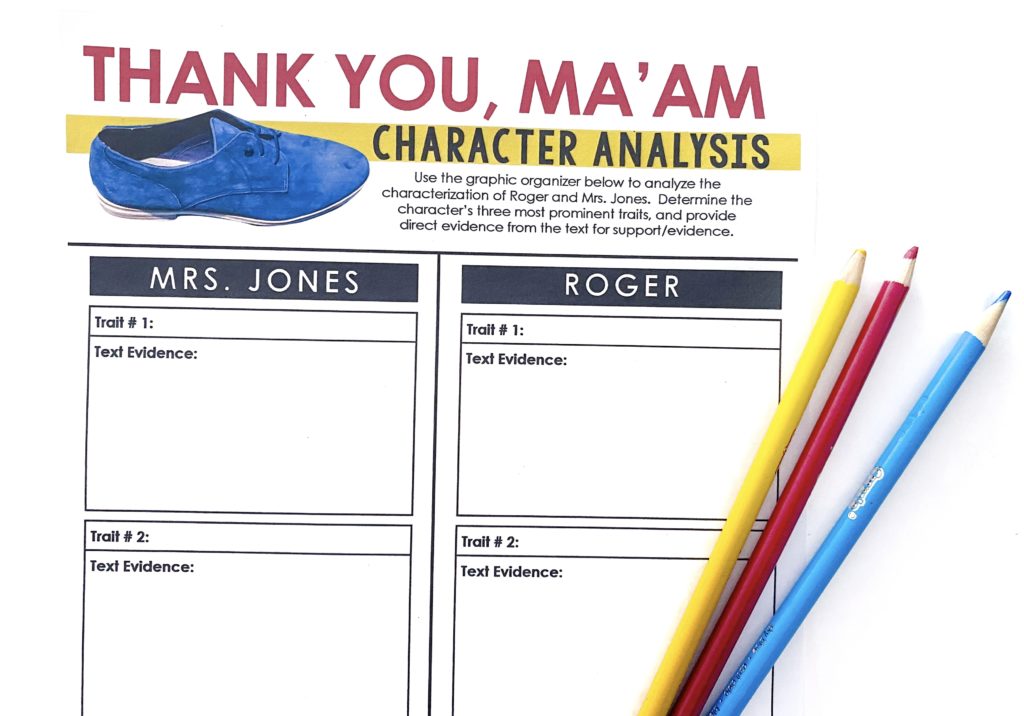
Analysis Notes
The next thing I do when teaching “Thank You, Ma’am” is guide students through some analysis notes that dive a little deeper into the text. This is where I cover important elements of the story that they might have missed or deserve closer attention. For this, I usually do some direct instruction on things like dialect, conflict, and allusion, which are all crucial aspects of the story.
For example, it is important to mention that most of “Thank You, M’am” is written in a conversational dialect. Langston Hughes uses the oral style from Harlem at the time to further develop his characters, especially Mrs. Jones. I also point out the allusion to Elvis Presley’s song “Blue Suede Shoes,” which they might have missed.
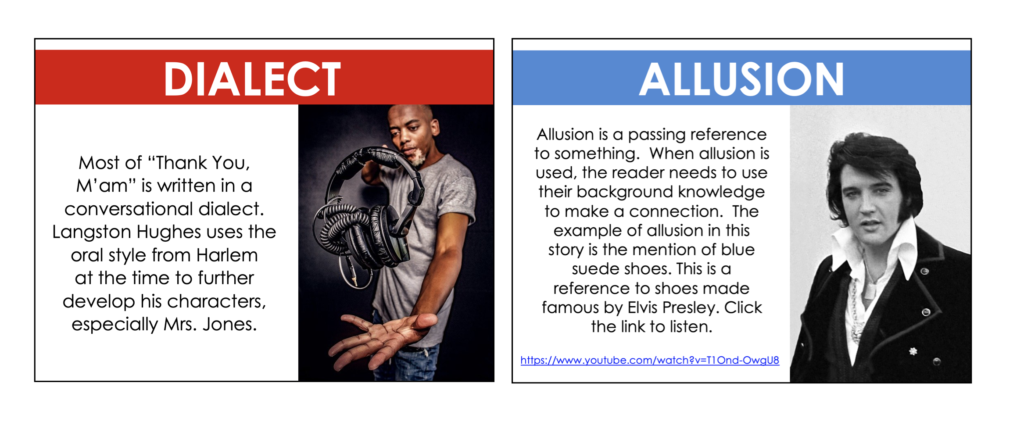
Creative Writing: Letter to Mrs. Jones
Finally, I typically end by getting students to write a letter to Mrs. Jones. For this creative writing activity, I have students imagine that they are Roger and that it has been 10 years since the encounter that occurs in this short story. I get them to write a thank-you letter to Mrs. Luella Bates Washington Jones to tell her what they did after they left her home, what they have been doing since the encounter, and what impact her actions and words have had on them using evidence from the text.
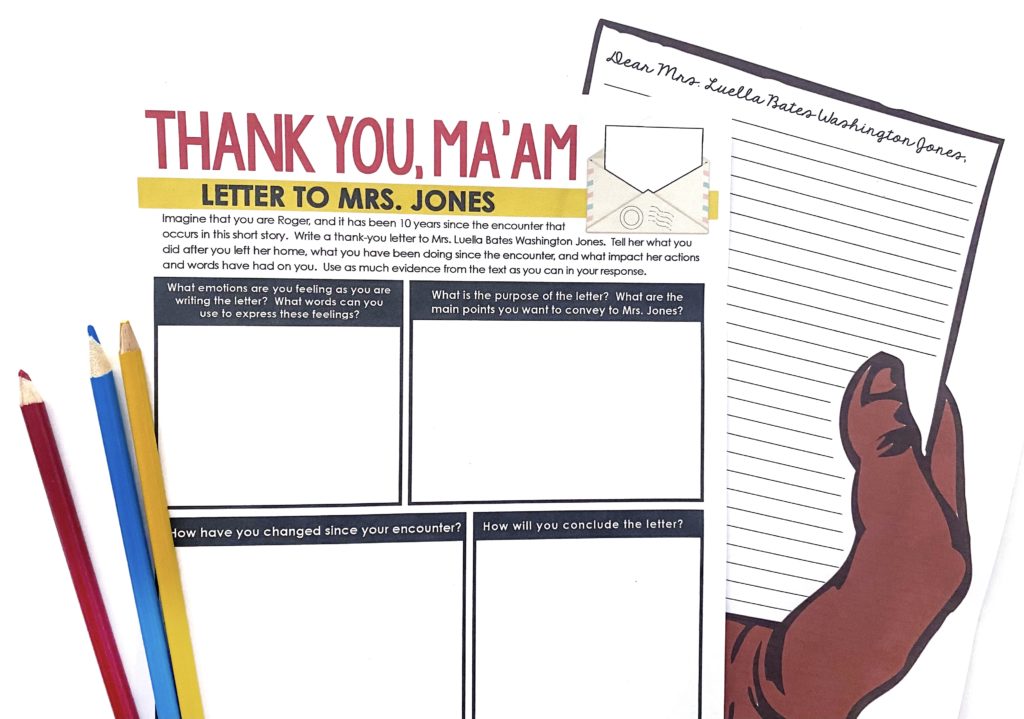
There you have it! I hope you enjoy teaching “Thank You, Ma’am” by Langston Hughes. If you would like to grab a ready-to-teach bundle with all of the resources mentioned above, you can do so by clicking below.
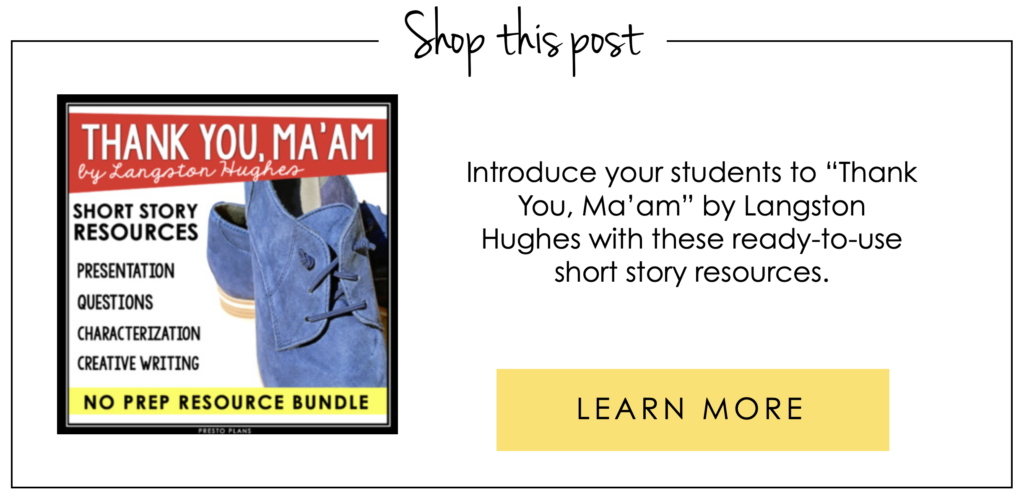
Prefer to grab it on TpT? No problem, just click here.
Here is what a few teachers who have used the resources already had to say:
- “I loved this product, particularly the letter to Mrs. Jones! The students loved the activity and some of their responses brought tears to my eyes. Thank you!” Ms. Bookmark (TpT Seller)
- “I love the biographical information on Langston Hughes! This is a great story and wonderful supporting resource!” Teresa Orndorff
Looking for more stories like this one? Read this blog post with 10 Short Stories to Teach in ELA with Teaching Tips.
Search the blog for what you are teaching
GIVEAWAYS
sent straight to your inbox!
share this post